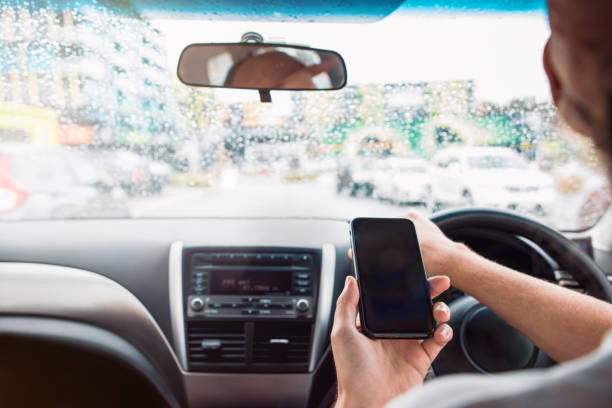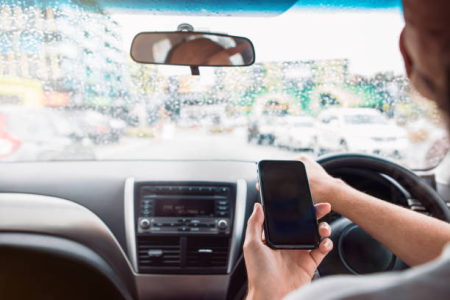
The numbers are sobering: in the last 12 months, 1,353 lives have been lost on Australian roads—a 4.3 per cent increase from the previous year. Even more concerning for our community is that older road users experienced an 18.1 per cent increase in fatalities for those aged 65-74 and a 9.3 per cent increase for those aged 75 and over.
Yet despite these alarming statistics, new research reveals most Australian drivers continue dangerous habits they freely admit to but seemingly can't shake—creating a perfect storm on our roads.

The habits we can't quit
While most of us try to follow the road rules, the latest data paints a concerning picture of our actual behaviour behind the wheel.
The numbers don't lie: 65 per cent of Australians admit to eating or drinking non-alcoholic beverages while driving, technically against the rules, while a whopping 60 per cent confess to fiddling with their music or GPS systems.
More alarmingly, 38 per cent of survey respondents admitted they'd been involved in an accident or near miss due to losing attention, with one in four drivers stating they were 'preoccupied' by a smartphone or smartwatch while driving.
'Australian drivers view their own behaviour behind the wheel through rose-tinted glasses'
The psychological aspect is particularly revealing. Despite less than half of respondents admitting to gawking at accidents, more than 60 per cent blamed other drivers for the same behaviour.
As AAMI's Mary Kennedy points out, this shows we tend to be biased towards our own behaviours, believing we're safer drivers compared to others.
The smartphone epidemic
Perhaps most troubling is our relationship with mobile phones. One-third of drivers admit to using their phone illegally while driving, yet the consequences are severe.
Hand-held phone use while driving increases the risk of crashing by 3.6 times, and drivers who use their phone while driving are 10 times more likely to crash.
More than 65 per cent of Australians surveyed say that sending a text message distracted them the most while driving, with this trend increasing by 12.27 per cent since 2022.
The physics are frightening: drivers who look away from the road for even two seconds can travel more than 33 metres in a vehicle moving at 60km/h, meaning four seconds can pass before the distracted driver can react to a road hazard.
The 'Fatal Five' causes of road crashes in Australia
Originally known as the 'Fatal Four,' distracted driving has earned its place as the fifth major cause of serious road crashes, joining speeding, drink driving, not wearing seatbelts, and fatigue.
Why seniors should be especially concerned
The latest road safety data reveals a troubling trend that directly affects our community. While road deaths increased across most age groups in 2023, the surge among older Australians was particularly stark.
In the 12-month period ending August 2025, 30.6 per cent of road deaths were aged 40 to 64 years (414 deaths), followed by 22.2 per cent of deaths for those aged 26 to 39 years (300 deaths) [9]. However, when we look at the percentage increases, the picture becomes more concerning for older drivers.
The combination of potentially slower reaction times with increasingly complex driving environments—from more distracted drivers on the road to rapidly changing technology in vehicles—creates additional challenges for senior drivers who may have been driving safely for decades.
Did you know?
Did you know? According to current Australian Road Rules, it's illegal to hold your phone in your hand or have it resting on any part of your body, including your lap, while driving—even when stopped in traffic or at traffic lights.
The distraction problem is as serious as drink driving
Research has shown that distraction is the main contributing factor in about 16 per cent of Australia's serious casualty road crashes, making distracted driving as serious a problem on Australian roads as drink driving [10].
This isn't limited to phones either. The survey found 40 per cent of motorists were preoccupied by other road users, including accidents and pedestrians.
Meanwhile, other dangerous habits persist: speeding was cited by 24 per cent of drivers, while 13 per cent confessed to experiencing road rage.
On the receiving end, around 2.9 times more males than females were involved in fatal crashes, with 1,005 male deaths compared to 347 female deaths in the 12 months to August 2025.
Road rage victims reported experiencing angry gestures (27 per cent), tailgating (25.6 per cent), and yelling or shouting (20.3 per cent).
Breaking the cycle
Despite knowing they're in the wrong, nearly a quarter of participants said they refused to change their bad behaviour unless they experienced road trauma personally—a concerning attitude that puts everyone at risk.
Simple steps to safer driving
- Put your phone in the boot or glovebox before starting your journey
- Set your GPS destination before you start driving
- Keep snacks and drinks within easy reach if you must eat while driving
- Take regular breaks on long journeys to combat fatigue
- Practice defensive driving techniques, especially around distracted drivers
- Consider modern safety features when upgrading your vehicle
The good news is that help is available. Modern vehicles increasingly come equipped with safety features designed to reduce the impact of human error, while smartphone apps can block notifications while driving. Some newer cars even include systems that monitor driver attention and provide alerts when distraction is detected.
Government response and road safety strategy
The Australian Government has recognised the seriousness of the situation. Through the National Road Safety Strategy 2021-30, the government aims to deliver significant reductions in road trauma deaths and serious injuries by 2050, working towards Vision Zero.
Australia has a 10-year strategy to improve safety on roads, with the Australian Government working with state and territory governments to deliver significant reductions in road trauma deaths and serious injuries by 2050.
The strategy recognises that managing speed and distraction are key challenges in implementing a Safe System approach to road safety.
Example Scenario
- If you're driving the same way you did 10 years ago, you might need to adapt to today's more dangerous road environment. More drivers are distracted, traffic is heavier, and the consequences of small mistakes can be severe. Consider refresher driving courses, newer safety technologies, and honest self-assessment of your driving habits.
Technology solutions for safer driving
While technology can be a source of distraction, it can also be part of the solution. Many modern smartphones have 'Do Not Disturb While Driving' modes that automatically activate when the phone detects you're in a moving vehicle. Similarly, newer cars come with features like:
- Lane departure warnings
- Automatic emergency braking
- Blind spot monitoring
- Driver attention monitoring systems
- Voice-activated controls for navigation and communication
For those driving older vehicles, aftermarket solutions like phone cradles with hands-free capabilities and dash cameras can improve safety without breaking the bank.
The path forward
The concerning trend of increasing road deaths, particularly among older Australians, demands urgent attention from all of us. While we can't control other drivers' behaviour, we can take responsibility for our own actions behind the wheel.
The data shows we're often our own worst enemies—admitting to dangerous behaviours while criticising others for the same actions. Breaking this cycle requires honest self-reflection and a commitment to change, even when it's inconvenient.
What This Means For You
Road safety isn't just about following rules; it's about protecting ourselves, our families, and our communities. With road deaths climbing and distracted driving now recognised as a major killer, every choice we make behind the wheel matters more than ever.
The technology exists to help us drive more safely, government strategies are in place to improve road conditions, and we know what behaviours to avoid. The question isn't whether we can make our roads safer—it's whether we're willing to change our habits to make it happen.
What driving habits do you think are most dangerous on today's roads? Have you noticed more distracted drivers lately, and what strategies do you use to stay focused behind the wheel? Share your thoughts and experiences below.
Primary Source
https://www.drive.com.au/caradvice/...-to/?utm_source=nine-rail&utm_medium=referral
Mobile Phone Use While Driving Statistics in Australia | Finder
Cited text: In the last 12 months (October 2024—September 2025), 1,353 lives have been lost in Australia due to driving—an increase of 4.3 per cent from the previous ...
Excerpt: in the last 12 months, 1,353 lives have been lost on Australian roads—a 4.3 per cent increase from the previous year
https://www.finder.com.au/car-insurance/mobile-phone-use-while-driving-statistics-australia
Road Safety Country Profile Australia 2024
Cited text: As · illustrated in Figure 1, this rise was particularly significant among older road users, with an 18.1 per cent increase in fatalities for those aged 65-74...
Excerpt: older road users experienced an 18.1 per cent increase in fatalities for those aged 65-74 and a 9.3 per cent increase for those aged 75 and over
https://www.itf-oecd.org/sites/default/files/australia-road-safety.pdf
The facts—distractions and driving—TAC—Transport Accident Commission
Cited text: 1/3 of drivers admit to using their phone illegally while driving · 1/3 of pedestrians admit to looking at their phone while crossing the road1 · Dist...
Excerpt: One-third of drivers admit to using their phone illegally while driving
https://www.tac.vic.gov.au/road-saf...ed-driving/the-facts-distractions-and-driving
Mobile phone use and distracted driving statistics in Australia | Mozo
Cited text: According to the Centre for Accident Research and Road Safety—Queensland (CARRS-Q), hand-held phone use while driving increases the risk of crashing...
Excerpt: Hand-held phone use while driving increases the risk of crashing by 3.6 times
https://mozo.com.au/insurance/car-i...nd-distracted-driving-statistics-in-australia
Mobile Phone Use While Driving Statistics in Australia | Finder
Cited text: According to the Transport Accident Commission, drivers who use their phone while driving are 10 times more likely to crash.
Excerpt: drivers who use their phone while driving are 10 times more likely to crash
https://www.finder.com.au/car-insurance/mobile-phone-use-while-driving-statistics-australia
Distracted Driving Survey & Statistics 2023—Budget Direct
Cited text: More than 65 per cent of Australians surveyed say that sending a text message distracted them the most while driving.
Excerpt: More than 65 per cent of Australians surveyed say that sending a text message distracted them the most while driving
https://www.budgetdirect.com.au/car-insurance/research/distracted-driving-statistics.html
Distracted Driving Survey & Statistics 2023—Budget Direct
Cited text: This trend has continued in 2023, increasing by 12.27 per cent since 2022.
Excerpt: this trend increasing by 12.27 per cent since 2022
https://www.budgetdirect.com.au/car-insurance/research/distracted-driving-statistics.html
Distracted Driving Facts | Budget Direct
Cited text: Drivers who look away from the road for even two seconds can travel more than 33 metres in a vehicle moving at 60km/h. This means that four seconds ca...
Excerpt: drivers who look away from the road for even two seconds can travel more than 33 metres in a vehicle moving at 60km/h, meaning four seconds can pass before the distracted driver can react to a road hazard
https://www.budgetdirect.com.au/car-insurance/guides/road-safety/distracted-driving-facts.html
Monthly road deaths | National Road Safety Data Hub
Cited text: In the 12-month period ending August 2025, 30.6 per cent of road deaths were aged 40 to 64 years (414 deaths). This was followed by 22.2 per cent of deaths for those ...
Excerpt: In the 12-month period ending August 2025, 30.6 per cent of road deaths were aged 40 to 64 years (414 deaths), followed by 22.2 per cent of deaths for those aged 26 to 39 years (300 deaths)
https://datahub.roadsafety.gov.au/progress-reporting/monthly-road-deaths
Distracted driving—Australian Automobile Association
Cited text: Research has shown that, distraction is the main contributing factor in about 16 per cent of Australia’s serious casualty road crashes. This suggests that dis...
Excerpt: Research has shown that distraction is the main contributing factor in about 16 per cent of Australia's serious casualty road crashes, making distracted driving as serious a problem on Australian roads as drink driving
https://www.aaa.asn.au/research-data/road-safety-research-program/distracted-driving/
Monthly road deaths | National Road Safety Data Hub
Cited text: In the past year, around 2.9 times more males than females were involved in fatal crashes. In the 12 months to August 2025, 1,005 males died in crashe...
Excerpt: around 2.9 times more males than females were involved in fatal crashes, with 1,005 male deaths compared to 347 female deaths in the 12 months to August 2025
https://datahub.roadsafety.gov.au/progress-reporting/monthly-road-deaths
National Road Safety Strategy
Cited text: The National Road Safety Strategy represents the commitment of federal, state and territory governments to an agreed set of national goals, objectives...
Excerpt: Through the National Road Safety Strategy 2021-30, the government aims to deliver significant reductions in road trauma deaths and serious injuries by 2050, working towards Vision Zero
https://www.roadsafety.gov.au/
National Road Safety Strategy
Cited text: Through the National Road Safety Strategy 2021-30 we aim to deliver significant reductions in road trauma together with our communities that will put ...
Excerpt: Through the National Road Safety Strategy 2021-30, the government aims to deliver significant reductions in road trauma deaths and serious injuries by 2050, working towards Vision Zero
https://www.roadsafety.gov.au/
Road Safety Country Profile Australia 2024
Cited text: Australia has a 10-year strategy to improve safety on its roads. Through the National Road Safety · Strategy 2021-30, the Australian Government is wor...
Excerpt: Australia has a 10-year strategy to improve safety on roads, with the Australian Government working with state and territory governments to deliver significant reductions in road trauma deaths and serious injuries by 2050
https://www.itf-oecd.org/sites/default/files/australia-road-safety.pdf







